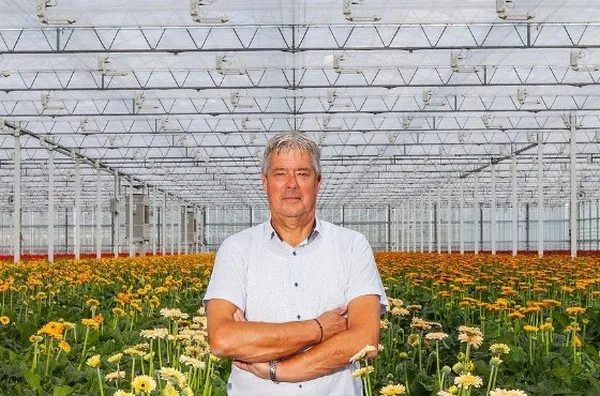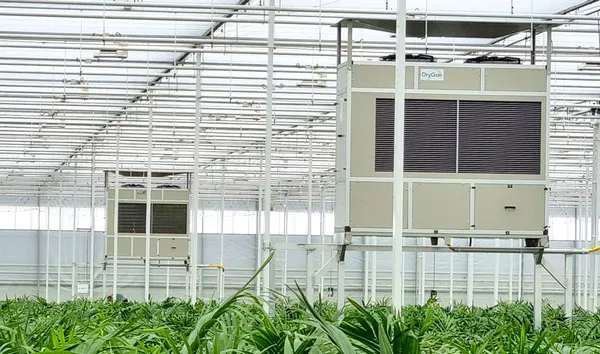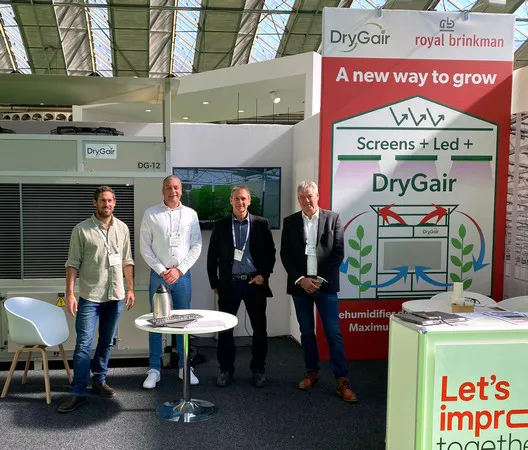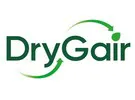Eef Zwinkels is Royal Brinkman’s technical account manager and the person to contact if you need advice or have questions about humidity or moisture problems in the greenhouse.
This interview was conducted with Zwinkels about DryGair’s ‘A New Way to Grow’ concept.
What is ‘a new way to trow’?
“’A New Way to Grow’ is a holistic and innovative way to grow greenhouse crops, using efficient lighting, thermal screens, and dehumidifiers,” Eef says. “This method was developed in order to optimize growth and yields and maximize energy savings. Growing according to these principles can save growers at least 50% on energy usage, minimize toxic sprays, and improve yield size and quality.”

Eef Zwinkels
Close the greenhouse and use thermal screens
Zwinkels continues, “The first step in gaining control over growing conditions is to close the greenhouse. Closing windows and vents, spreading thermal screens, and improving insulation will help keep heat inside the greenhouse. This lets growers drastically reduce their heating requirements and therefore reduce their energy consumption.
Thermal screens are a critical part of this. Deploying a single thermal screen can reduce heat loss by around 60%. However, growers can take this one step further and incorporate multiple screens. Combining 2 or even 3 screens can boost heat retention up to as much as 90%.
Reducing such a large amount of heat loss directly impacts heating protocols. If you can retain 90% of the heat you generate inside the greenhouse, you effectively reduce heating by 90%. That’s a lot of energy savings.”
Use efficient LED grow lights
“The next step in optimizing growth is to provide optimal lighting for your crop. While lighting used to be a major source of energy consumption, new LED technology allows growers to light their greenhouse at a fraction of the cost.” Eef says.
“Growers can use grow lights to complement sunlight or even replace sunlight during certain periods. This means the plants always receive their ideal amount of radiation and light spectrum.
Using grow lights for radiation also lets you provide full coverage and uniformity during the entire day. So you can completely avoid fluctuations or low radiation caused by natural weather patterns.”
Control humidity using dehumidifiers
“Closing the greenhouse, spreading thermal screens, and using powerful grow lights leads to a very serious problem – high humidity.”
Eef explains, “Traditionally, greenhouse growers would deal with humidity by combining heating and venting. However, this method is highly problematic, being very inefficient and often ineffective. Releasing air from the greenhouse also releases heat, so growers must keep reheating constantly. This constant heating requires massive amounts of energy and is a huge expense for growers, especially in colder climates such as in much of Europe and North America.

The heat and vent method for humidity control was developed decades ago, long before the introduction of greenhouse dehumidifiers. Today, commercial horticulture dehumidifiers are readily available, and any grower can incorporate them in the greenhouse.
Using dehumidifiers to remove humidity from the greenhouse space completely solves the problem of humidity without requiring any ventilation. So growers can keep the greenhouse completely closed and treat humidity from the inside.
DryGair dehumidifiers are designed specifically for horticultural use. They’re optimized for maximum energy efficiency and are engineered to be as effective as possible under real-world greenhouse conditions. Using DryGair, rather than ventilation, can save at least 50% on energy consumption and more.” Zwinkels says enthusiastically.
“This is also due to the recovery of latent energy. With other systems, this is lost because it disappears through cracks in the screen cloth and open vents. While with DryGair, everything can remain 100% closed. That makes a big difference in energy savings.
DG dehumidifiers also provide an added benefit to air circulation. The patented air circulation mechanism, included in every DG model, uses 360° air distribution to ensure uniform conditions everywhere in the greenhouse.”

Maximize yields and energy savings
“Combining thermal screens, efficient lighting, and DryGair dehumidifiers provides the perfect conditions for greenhouse growing. It lets growers gain full control over their growing conditions without compromising humidity, as was traditionally the case.
The profitability of using these growing principles is directly affected by energy prices. As energy prices rise, this method becomes more and more profitable, reducing the ROI on the necessary systems and equipment.”
For more information:
DryGair Energies
www.drygair.com
Royal Brinkman
info@royalbrinkman.com
www.royalbrinkman.com
